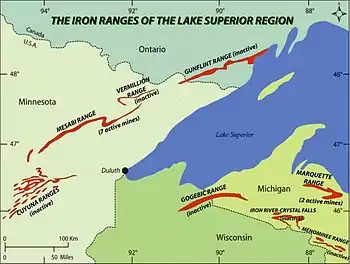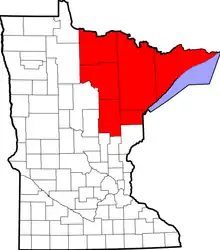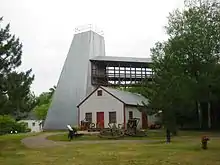Iron Range
The term Iron Range refers collectively or individually to a number of elongated iron-ore mining districts around Lake Superior in the United States and Canada. Despite the word "range", the iron ranges are not mountain chains, but outcrops of Precambrian sedimentary formations containing high percentages of iron.[1] These cherty iron ore deposits are Precambrian in age for the Vermilion Range and middle Precambrian in age for the Mesabi and Cuyuna ranges, all in Minnesota. The Gogebic Range in Wisconsin and the Marquette Iron Range and Menominee Range in Michigan have similar characteristics and are of similar age. Natural ores and concentrates were produced from 1848 until the mid 1950s, when taconites and jaspers were concentrated and pelletized, and started to become the major source of iron production.[2]

The region's far eastern area, containing the Duluth Complex along the shore of Lake Superior, and the far northern area, along the Canada–US border, are not associated with iron ore mining. Due to its shape, the area is collectively known as the Arrowhead region of Minnesota. It consists of seven counties: Aitkin, Carlton, Cook, Itasca, Koochiching, Lake, and Saint Louis.
The Iron Range and its economy



From a geological perspective, Minnesota's Iron Range includes these four major iron deposits:[3]
- Mesabi Range, the largest iron range, largely within Itasca and Saint Louis counties;
- Vermilion Range, northeast of the Mesabi, in Saint Louis and Lake counties;
- Gunflint Range , in the extreme northern portion of Cook County and extending into Canada; and
- Cuyuna Range, southwest of the Mesabi, largely within Crow Wing County.
Within Minnesota, "The Iron Range Resources and Rehabilitation is a State Department, established by the legislature of 1941 to render public service through research and the actual development of all the state's resources both natural and human."[4] The Iron Range Resources and Rehabilitation Board (IRRRB), known as "the I-triple-R-B" or Iron Range Resources,[5] is an economic development agency funded partly by state taxes on taconite-producing companies and charged with creating jobs.
History
Geologically, the iron ranges in Minnesota belong to the Animikie Group. The geologic history of the formations containing iron are typical of banded iron formations worldwide.[2]:502–504
Before the 19th century, Native American groups mined native copper on the Keweenaw Peninsula. William Austin Burt discovered iron ore in the Marquette Range near Negaunee, Michigan in 1844. Iron ore was discovered on the Menominee Range in 1867, on the Gogebic Range in 1884, on the Vermilion Range in 1885, the Mesabi Range in 1890, and the Cuyuna Range in 1903.[2]
Underground mines were developed to remove the valuable ore of most ranges. But on the Mesabi and Cuyuna Ranges, iron mining operations evolved into enormous open pit mines, where steamshovels and other industrial machines could remove massive amounts of ore. "Large-scale commercial production of magnetite taconite ore on the Mesabi Range started in 1956 at the Peter Mitchell Mine near Babbitt, Minnesota."[2]
Cities
The Iron Range contains several smaller towns. Some of the more significant communities in the region include:
- Aitkin (pop. 2,165) is on the Cuyuna Range 's eastern edge. It was the birthplace of stage and film actor Warren William.
- Aurora (pop. 1,853) is on the Eastern Mesabi Range. The former St. James, Meadow, Miller and Stephens mines lie within the city limits.
- Babbitt (pop. 1,475)
- Biwabik (pop. 969)
- Bovey (pop. 804) is along U.S. Highway 169 between Coleraine and Taconite . It was the birthplace of NHL goaltender Adam Hauser, San Francisco politician Richard Hongisto, and Eric Enstrom , photographer of the famous 1918 photograph "Grace."
- Buhl (pop. 1,000) is along U.S. Highway 169 between Chisholm and Virginia . It is known for its fine water and claims "The Finest Water in America" on its water tower.
- Chisholm (pop. 4,976) is the geographic center of the Mesabi Range, home of the Chisholm Bluestreaks. It is the home of the Minnesota Discovery Center , the Minnesota Museum of Mining, and the Iron Range Research Center. Archibald "Moonlight" Graham, subject of the motion picture "Field of Dreams ", settled in Chisholm. The motion picture "North Country" was also partly filmed in Chisholm.
- Coleraine (pop. 1,970) has been called the "start place of the Iron Range." It was built in the early 20th century to accommodate the miners of the Oliver Iron Mining's Canisteo Mine. John Greenway was the superintendent of the mine; Greenway School District in Coleraine is named for him.
- Crosby (pop. 2,386) is an old mining boomtown on the Iron Range's southwestern edge, home of the Crosby-Ironton Rangers.
- Duluth (pop. 86,265) The fourth largest city in the state, while not part of the Iron Range, is a destination for much of its production shipped via the DM&IR railroad. Iron pellets are shipped "downward" through the Soo Locks to steel towns such as Cleveland, Erie, and Toledo. The Port of Duluth allows the iron ore to be easily shipped through the Great Lakes.
- Deerwood (pop. 529) Mining engineer Cuyler Adams discovered the Cuyuna Range near Deerwood in 1895.
- Ely (pop. 3,460), in the Vermillion Range, is perhaps best known as the most popular entry point for the Boundary Waters Canoe Area Wilderness.
- Eveleth (pop. 3,718) is where U.S. Senator Paul Wellstone and seven others died in a plane crash in 2002 two miles from the municipal airport. It also the site of the conflict that resulted in the landmark sexual harassment class action case Jenson v. Eveleth Taconite Co. and the film North Country , and home to the United States Hockey Hall of Fame.
- Grand Rapids (pop. 10,869) is named for the local rapids in the Mississippi River , which was the uppermost limit of practical steamboat travel during the late 19th century. Today, those rapids are hidden underneath the dam of the Blandin Paper Mill, which has its papermaking facilities in downtown Grand Rapids. The city is considered to lie on the Mesabi Range's westernmost edge. The economy has a large tourist footing, with many local resorts, golf courses, and regional hunting and fishing. Grand Rapids is the birthplace of entertainer Judy Garland.
- Gilbert (pop. 1,799) is home of one of Minnesota's most well known off-highway vehicle parks. It is also the location of Lake Ore-be-gone , an artificial lake created by flooding three open-pit iron ore mines.
- Grand Marais (pop. 1,351) The area was a bustling fur trading station since the 1700s, and the French voyageurs called the settled village Grand Marais ("Great Marsh"), referring to a marsh that in early fur-trading times was 20 acres (8.1 ha) or less in area, nearly at the level of Lake Superior, and situated at the head of the little bay and harbor that led to the settlement of the village. The town comprises much of the Gunflint Trail, which extends to the former Paulson Mine site.
- Hibbing (pop. 16,361) is the largest city by area in the state of Minnesota and the boyhood home of Bob Dylan and basketball great Kevin McHale . It is home to the Hull–Rust–Mahoning Open Pit Iron Mine , one of the world's largest open pit iron mines. Hibbing is also the birthplace of Roger Maris.
- Hoyt Lakes, Minnesota (pop. 1,888) is in the eastern Mesabi Range. Erie Mining Company previously mined ore and testing to mine new minerals is ongoing.
- Keewatin, Minnesota (pop. 1,068) is between Nashwauk and Hibbing. It is home to U.S. Steel's KeeTac taconite mining and processing plant. It is the hometown of New England Patriots Hall of Famer Gino Cappelletti and Big Ten College Baseball's record holder for most career wins and current Minnesota Gophers baseball coach John Anderson.
- Kinney (pop. 169) is an old mining boomtown on the Iron Range, between Buhl and Mountain Iron.
- Mountain Iron (pop. 2,869) is home to Minntac, the world's largest taconite processing plant.
- Nashwauk (pop. 983) is a small town between Grand Rapids and Hibbing, 4 miles from Keewatin. A few pit lakes in the area now hold bass, lake trout, and northern pike. As of 2010, Essar Minnesota Steel is constructing a new direct-reduction steel producing facility north of town. It is a first for the Iron Range, as it will have blast furnaces on-site to produce steel from the mining of taconite.
- Soudan is an unincorporated community in Breitung Township, Saint Louis County immediately east of the city of Tower on Minn.Highway 169 / Minn.Highway 1, where the area school and business district are. It is the home of the Soudan Underground Mine State Park , which contained the University of Minnesota's Soudan Underground Laboratory, which housed detectors, including MINOS, over 700 meters below the earth's surface.
- Taconite (pop. 360), named after the taconite pellets from iron ore, was a town many miners lived in. It recently celebrated its centennial year and is famous for its rich hockey tradition.
- Two Harbors (pop. 3,745) is the county seat of Lake County, along the shore of Lake Superior. The town was historically an important port for loading and shipping iron ore from the Range. But like Duluth, Two Harbors is not itself a mining town.
- Virginia (pop. 8,712) is next to the Rouchleau mine pit , which is nearly three miles long, a half-mile wide and 450 feet deep. It is the major retail shopping center in the northern Iron Range, and has the Thunderbird Mall . Four miles north of Virginia is the Laurentian Divide, which separates the watershed of the streams that flow north to the Arctic Ocean from the watershed of the streams that flow southeast through the Great Lakes to the Atlantic Ocean. The motion picture North Country was also partly filmed in Virginia, notably the courthouse sequences.
- Winton (pop 172). Once several times larger than Ely, Winton sits just 3 miles north of Ely, and was once home to a very large lumber mill and a lumber boomtown.
Culture
The area has Finnish, Italian, Slavic, and Scandinavian/Nordic heritage, with immigration strongly linked to the mining industry. A noticeable northern Minnesota accent is present in the area, especially among older people, hence the popular nickname "Da Range". Ice hockey is a predominant sport in the region, which has produced several NHL players as well as all three members of the "Iron line" from the 1980 U.S.A. Hockey Miracle on Ice team.
The regional culture is strongly linked to former periods of steady, usually well-paid mining employment, although in recent decades, the region's outdoor recreation and relative remoteness has attracted new residents unconnected to the industry.[6] There are tensions between supporters and detractors of mining, especially over the potential reuse of ironworks to exploit copper ores. Bob Dylan, who grew up in Hibbing, memorialized the Iron Range in the 1963 song "North Country Blues", a lament portraying hard times in the region. Presented in his 1964 album The Times They Are a-Changin', it includes such lines as:
- So the mining gates locked and the red iron rotted
- And the room smelled heavy from drinking
- When the sad, silent song made the hour twice as long
- As I waited for the sun to go sinking [7]
The Iron Range is known for Cornish pasties stuffed with a combination of ground beef and pork, rutabaga, onion, carrots, and potatoes. Pasties were an easy lunch for those working deep in the iron mines.[8] Slovenian and Croatian immigrants brought the honey-nut bread potica to the Iron Range; it is still served on Easter and Christmas in northern Minnesota.[9]
Politics
The area has remained a Democratic-Farmer-Labor Party stronghold because of its history of a largely unionized workforce in the mining industry, the mainstay of the economy of the Iron Range. In 2004, John Kerry carried most of the counties in the region by a comfortable margin. This was perhaps aided by George W. Bush calling the area the "Iron Ridge" in a campaign speech. Barack Obama outperformed McCain in 2008, carrying every county in the Range. The area was the largest rural Democratic stronghold in Minnesota outside of the urban centers in Minneapolis and St. Paul. In 2016, Donald Trump's populist economic policies changed the Range's electoral profile. He won multiple counties, reduced past Democratic winning margins and received endorsements from local Democratic mayors.[10][11]
Climate
The region is known for harsh winters and pleasant summers. The average year-round temperature is in the 30s °F (between about 2 °C and 4 °C). Temperatures below −40 °F/°C occur somewhere in the region during most winters. The Midwestern Regional Climate Center climate summaries[12] record that Virginia has a mean annual temperature of 38 °F, with an average January low temperature of −6.2 °F (about −21 °C) and July high of 77.4 °F (25 °C). Precipitation there averages 27 in (690 mm) annually and snowfall 53.2 in (135 cm). Near Lake Superior, the temperature differences are somewhat less extreme, but due to its proximity to the lake annual snowfall over 100 inches is common.
See also
References
- Aldrich, Henry (1929). The Geology of the Gogebic Iron Range of Wisconsin. State of Wisconsin. p. 5.
- Marsden, Ralph (1968). John D. Ridge (ed.). Geology of the Iron Ores of the Lake Superior Region in the United States, in Volume 1 of Ore Deposits of the United States, 1933–1967. The American Institute of Mining, Metallurgical, and Petroleum Engineers, Inc. pp. 490–492.
- "2 Billion Years Ago: Iron Range Beginnings". Minnesota Historical Society. Archived from the original (Timepieces) on August 9, 2011.
- Gruner, John (1946). The Mineralogy and Geology of the Taconites and Iron Ores of the Mesabi Range, Minnesota. Office of the Commissioner of the Iron Range Resources and Rehabilitation. p. Foreword.
- "IRRR Advisory Board Members". Department of Iron Range Resources & Rehabilitation.
- Erik Kojola. 2020. Divergent memories and visions of the future in conflicts over mining development. Journal of Political Ecology 27: 898-916. https://doi.org/10.2458/v27i1.23210
- "Bob Dylan - North Country Blues Lyrics". Metro Lyrics.
- Pease, Krystyna (December 2, 2015). "Appetites: Preserving Iron Range recipes". MPRNews. Minnesota Public Radio.
- Ostman, Eleanor (February 21, 2007). "Memories of potica". Chicago Tribune.
- McGreal, Chris (October 16, 2020). "'The Democratic party left us': how rural Minnesota is making the switch to Trump". the Guardian. Retrieved October 16, 2020.
- Slater, Brady (September 4, 2020). "Some Iron Range mayors surprised, disapproving of Trump endorsement". Duluth News Tribune.
- "Midwest Climate: Climate Summaries". Midwestern Regional Climate Center. Retrieved November 1, 2020.
External links
| Wikimedia Commons has media related to Iron Range. |
- Mining Communities in Northeastern Minnesota with a map
- Mn DNR
- Minnesota Historical Society
- Iron Range Research Center Digital Collection Minnesota Reflections

